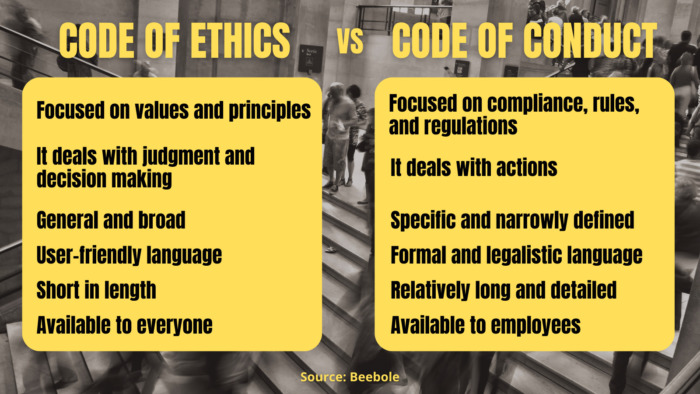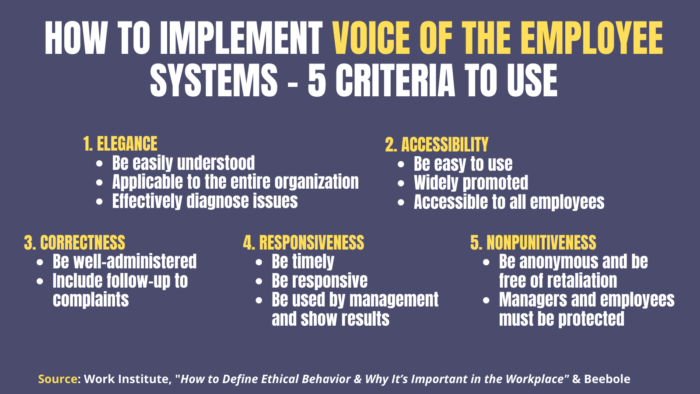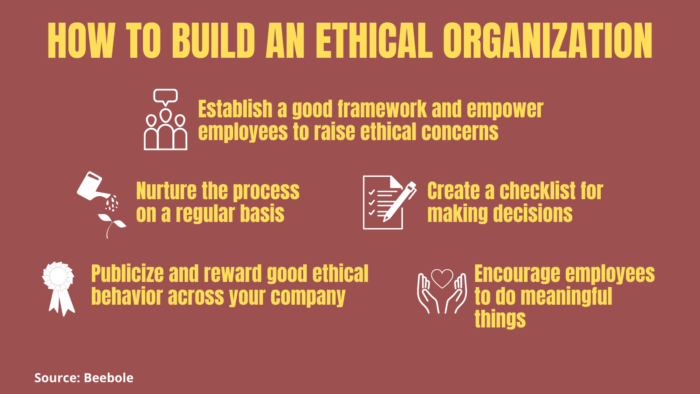How to promote workplace ethics in your business


Table of Contents
Table of Contents
Concerned about workplace ethics? You should be. As it turns out, simply hiring good people and hoping they’ll make the right decisions isn’t enough. And while making a good hire is a step in the right direction, it’s just the beginning of your journey to leading an ethical company. If you actually want to encourage ethical behavior within your organization, you must invest time and resources in educating and inspiring your team.
Before things get messy, let’s clear up the difference between the following terms related to workplace ethics.
A code of conduct is a written document that highlights a company’s mission, vision, and values in order to establish the obligations, rules, and regulations that employees should follow. A code of conduct is an essential part of a compliance program that defines an organization’s dos and don’ts.
A code of ethics or ethical code is a written document that outlines the values and principles that guide a company’s business operation. This guide is designed to help employees conduct business with honesty and integrity. This document should provide guidance to employees and influence their company-related decisions.
So, there are certain similarities between the code of ethics and the code of conduct—Both documents play an important role in shaping people’s behavior. But keep in mind that while they share a similar purpose, they are different.

To understand the organization purpose of an organization, you need to answer this question:Why are we in business? The answer should be bold and inspiring—a short statement that underlines the very reason everyone comes to do their job each day. The answer will most likely be related to a company’s mission, cause, or culture.
This comes down to ethical values (e.g. honesty, integrity, respect, fairness) and business values (e.g. innovation, community impact, customer-focused). Defining these sets of values helps set the tone for the way in which a company will conduct business. According to the Institute of Business Ethics, “business values are what the company will deliver; ethical values are how the business values will be achieved.”
Now that we’ve tackled some of these related terms, let’s go deeper into workplace ethics and the nature of unethical behavior.
Quite simply, workplace ethics is the application of ethics in the workplace. According to human resources author Paul Falcone, workplace ethics is “the application of an ethical code of conduct to the operational and strategic management of an organization and its leadership and people practices.”
Dr. Thomas Mahan, author at Work Institute, puts it differently. He refers to ethics in the workplace as the “the moral code that guides the behavior of employees with respect to what is right and wrong in regard to conduct and decision making.” That’s why corporate ethics touches every single aspect of a business.
The construction of ethical workplace cultures depends on how employees apply ethics in the workplace. According to The Institute of Business Ethics (IBE), “an ethical culture is a combination of factors that define the way people within an organization behave and make decisions.” That combination starts with a clear purpose and a set of ethical values that can influence behaviors and daily interactions among people.
Those behaviors and interactions represent the norms—what people do when no one is looking—of an ethical culture. In fact, in order to understand what an ethical culture means, you need to differentiate the rules (compliance) from the norms (culture) of an organization. According to Daniel Beunza, Associate Professor of Management at Bayes Business School, City, University of London, the norms represent the key element of an ethical culture. “It’s the norms that are internalized,” argues Beunza on an IBE webinar about building an ethical culture.
Similarly, Deborah Allen, Group Director Governance, Conduct & Sustainability at BAE Systems, highlights the influence that an ethical culture has on the choices people make in a company. “When I’m making decisions about how I behave in a meeting, the tone of my emails, all of that is a choice, it’s not a compliance tick box,” states Allen.
Before promoting workplace ethics across your company, it’s important to understand the dynamics of unethical behavior and why it happens. Let’s start with some of the insights that Mark Chambers, Associate Director – Governance at IBE, shared in an article where he explored a very simple question: Why do good teams go bad?
To begin with, “corporate wrongdoing is rarely restricted to a group of ‘bad apples’ in the workforce,” argues Chambers. That, however, doesn’t mean that companies that go wrong are full of bad people. Quite the opposite. According to Chambers, “the problems come when decent people across the organization collectively lose their moral compass. The reality is that good teams can go bad, with a gradual cultural drift that eventually engages and consumes everyone.”
The Enron scandal is one of the best examples of how that gradual cultural drift tore apart an organization. “The Enron Fraud is the story of synergistic corruption. There are supposed to be checks and balances in the system. The lawyers are supposed to say no, the accountants are supposed to say no, the bankers are supposed to say no, but no one who was supposed to say no, said no,” recalls Bill Lerach, attorney for the shareholders suing Enron.
So, what does it take for decent employees to lose their moral compass? In most cases, it is a combination of factors. Things like judgment ambiguity, confirmation bias, others’ behavior, and excessive and undue pressure to achieve specific targets can negatively affect the ethical behavior of good employees.
Brooke Deterline, Founder and CEO of Courageous Leadership, reminds us that “it is a natural human tendency to be a bystander, to follow a leader or a group that we know is doing something wrong for a sense of acceptance or a sense of security.” Such a sense of acceptance and security is reinforced even more when there’s pressure to accomplish specific goals. “When we’re focused on operational objectives and you throw pressure on top, the ethical implication of our acts will fade from our minds,” affirms Deterline.
With this in mind, there are three main ideas to understand:
Don’t be discouraged—there are several tactics business leaders can employ to counteract good apples from going bad. First thing’s first: Understand “ethical danger zones,” and act upon them in a timely manner. According to Steven D. Olson, director of the Center for Ethics and Corporate Responsibility at Georgia State University, you need to watch out for the following danger signs in your organization:

Second, and most important, if you want to build an ethical culture in your company, you need to create a system that encourages employees to act in an ethical way. As stated by professors Nicholas Epley and Amit Kumar, “Real people are not purely good or purely evil, but are capable of doing both good and evil.” That’s why “organizations should aim to design a system that makes being good as easy as possible.”
Of course the golden question is, “How do I do that?” Luckily, there are some effective strategies you can implement within your organization. Before we jump into those, let’s look at why these kinds of strategies actually matter, and how both good and bad ethical behavior can impact your company.
There are a plethora of powerful arguments to show you why promoting workplace ethics in your company should be a priority.
Your employees’ unethical conduct can seriously damage your company’s reputation and credibility. If that happens, your brand and corporate image can suffer, and recovering from that (if that’s even a viable option) likely requires a huge investment of time and money.
Apart from diminished reputation and credibility, Jason Gatchalian of HRZone, lists the following problems as some of the most negative effects associated with unethical conduct:
While unethical conduct can severely undercut your business, let’s see how good ethical behavior can have a positive effect, replete with great benefits. According to Dr. Mahan, the perception of ethical behavior can have a very positive impact in the following:
If you want to build a work environment with the potential to become a great place to work, promoting workplace ethics is a no-brainer. But this is no easy task, and it comes with a unique set of challenges.
Let’s look at the most common issues affecting business ethics. Each one poses a challenge you need to be aware of if you’d like to promote an ethical culture that allows you to enjoy all the benefits that come with it.
Despite their significant impact, most organizations still treat business ethics as something abstract that is often limited to a code of conduct that most employees only see when they join a new company or during an isolated corporate event. In other words, there is a substantial lack of ethical training across the corporate world. In fact, a study cited by professors Isaac H. Smith and Maryam Kouchaki, found that much of the work ethics training at 71 large U.S.-based companies “was delivered in short doses and infrequently, such as annually or only during new-hire orientations.”
Challenge #1: Change your mindset regarding business ethics training, and treat it as an ongoing process.
The workplace environment plays a critical role in business ethics. When your workplace is defined by high pressure and poor peer behavior, and you add in the fear of losing that sense of acceptance and security mentioned earlier, the odds of facing an ethical problem are high.
One of those problems is low reporting, which occurs when employees witness unethical behaviors but don’t say anything about it. According to an article written by Gallup authors Nate Nvorak and Alex Power, a study on the U.S working population found that “24% of respondents reported seeing or being aware of unethical behavior in their workplace in the past 12 months—and less than half of them, 47%, chose to report the issue.”
That’s a lot of unethical behavior flying under the radar. Why? Because of poor workplace environments dominated by low engagement and high levels of frustration and fear. Below, you’ll find the main reasons behind the low reporting rate highlighted by the Gallup Panel study:

Challenge #2: Build a workplace environment guided by ethical and moral principles.
Most companies take the wrong approach when dealing with business ethics. According to professors Nicholas Epley and Amit Kumar, “compliance programs increasingly take a legalistic approach to ethics that focuses on individual accountability. They’re designed to educate employees and then punish wrongdoing among the ‘bad apples’ who misbehave.”
This approach has two main problems:
Challenge #3: Don’t treat work ethics as a belief problem, but rather as a design problem.
Context is key in shaping work ethics in an organization. Here are five tips to help you take action and design an environment that allows employees to act ethically.
There are certain elements that you need to integrate into your organization if you want to foster good ethical standards. To begin with, you need to define a clear purpose for your organization, as well as a set of values that help you define how you do your business.
You then need to put together a code of ethics that helps employees make decisions according to the company culture. You can integrate this code with a code of conduct more focused on the regulations and rules that employees should follow across the organization.
When ready, promote these values and the codes using all of your communication channels. You want to raise awareness and ensure that both employers and employees are guided by the right questions. As stated by professors Nicholas Epley and Amit Kumar, “people working in an ethical culture are routinely triggered to think, ‘Is it right?’ rather than ‘Is it legal?’”
Finally, it’s key to create specific procedures that allow employees to raise ethical concerns. This is a very effective way of dealing with low reporting. Put in place employee voice tools (e.g. interviews, surveys) that help you promote and model ethical behavior and encourage employees to report unethical conduct.
“The single most important thing organizations can do different to promote ethical behavior is to implement a proactive employee voice system and use voice of the employee tools to proactively give employees the capacity to be heard,” states Dr. Mahan, who also suggests using the following criteria when doing that:

The Ethics Resource Center’s Six Elements of an Ethics and Compliance Program provides a great summary of what to keep in mind when building your own workplace ethics:
Building an ethical culture is an ongoing process that you need to review and nurture on a regular basis. Experiential training, storytelling and regular discussions are some tools to keep ethics top of mind within your organization. As stated in Deloitte’s report Corporate culture:The second ingredient in a world-class ethics and compliance program, “communicating values is much like a marketing campaign—it needs to capture people’s attention and use different content, formats, and communication channels to remain fresh.”
In their article about building an ethical culture, professors Isaac H. Smith and Maryam Koukachi make an interesting reference to Lockheed Martin and how this company uses an experiential training program to promote an ethical culture throughout the organization. “Employees watch videos of scenarios involving everyday ethical challenges they might encounter at work. Small groups discuss the scenarios and explore techniques for upholding moral values, such as asking questions, reframing issues to take various perspectives into account, and developing guidelines about when and how to report violations,” explain the authors.
A “yes” check is one of the most effective and practical tools you can use to foster an ethical culture within your organization. Simply provide employees with a set of questions they can use every time they face ethical dilemmas.
On the previously mentioned IBE webinar, Roger Farley, an HR professional at NatWest, shared the following list of five questions that help people to make decisions:
These questions can differ from organization to organization. The important thing is to come up with solid criteria that fit into the purpose of your organization and provide guidance to employees facing ethical issues.
Many organizations choose to highlight wrongdoing to foster ethical awareness among their employees. However, if you want to create more ethical norms across your organization, try the opposite approach. How? According to a Gallup article on compliance, role modeling may be one of the most effective ways of achieving this.
For instance, “if a hiring manager asks HR to strip names from resumes to prevent unconscious bias in his decision-making, let all hiring managers know. If a production manager refuses a sweetheart deal from a vendor charged with human rights violations, her peers should hear about it,” argue Gallup professionals Jennifer Robison, Alex Power, and Dan Grafstein.
You can further reinforce this strategy if you match exemplary behavior with the incentives and promotions that your organization offers. If people see that good behavior has real implications in terms of career growth and/or salary increases, they will feel more motivated to adopt ethical behaviors on a regular basis.
Business ethics is not only about helping employees avoid wrongdoing. In fact, as stated by professors Isaac H. Smith and Maryam Kouchaki, building a truly ethical culture requires empowering people to do good things, too.
According to these scholars, “serving other people can reduce self-focus and raise awareness of moral concerns. It also contributes to psychological flourishing; studies have demonstrated a link between volunteer service and improved mood and well-being.”
There are many companies that encourage employees to give back to their communities. Every year, for example, Salesforce employees are entitled to seven paid days off for volunteer work in their communities. These kinds of opportunities go a long way, not only in terms of building workplace ethics, but also for engagement and motivation.

Whether you are a manager working for a big company or the owner of a small business, we hope you prioritize building workplace ethics in your organization. The benefits of building a work environment where you bring out the best of people speak for themselves.
If you can implement the tips shared throughout this article, your chances of creating an ethical organization are much higher. As stated by professors Nicholas Epley and Amit Kumar, “doing so will never turn an organization full of humans into a host of angels, but it can help them be as ethical as they are capable of being.”
—
Photo by Christina @ wocintechchat.com on Unsplash
According to Deloitte Insights’ most recent Global Human Capital Trends report, “automation, cognitive computing, and crowds are paradigm-shifting forces that will reshape the workforce now and in the near future”. What makes the augmented workforce, as Deloitte calls it, so different from what we know now? Automation takes away a lot of the busy work […]
There are three words that have transformed business intelligence (BI) into one of today’s most popular topics: data, data and data! That’s right. Not too long ago, the most important decisions of a company were defined by accumulated experiences and intuition. Today, however, effective management is defined by actionable, data-driven information. Gone are the days […]
We live in times where, often, remote work is no longer an optional arrangement. Today, the question is not so much if but how to build a remote work strategy. However, the road that leads to a healthy remote work strategy can be bumpy if you’re not aware of the obstacles along the way. From […]